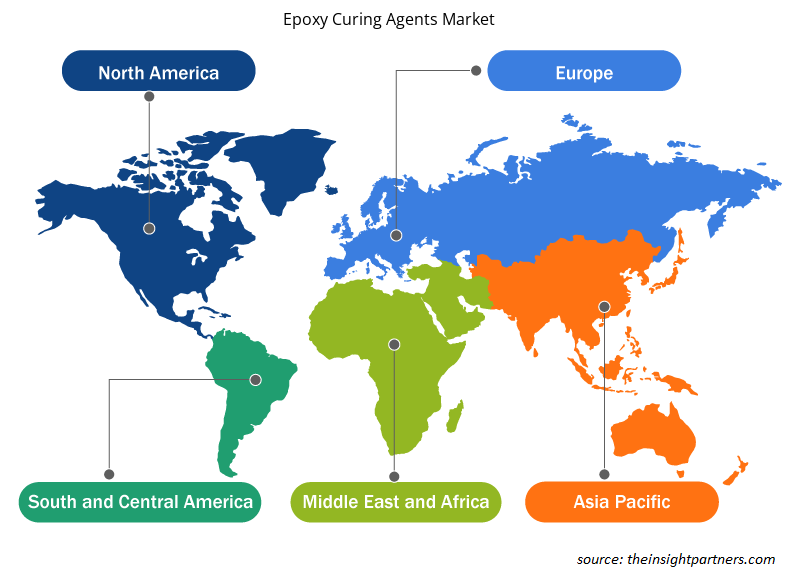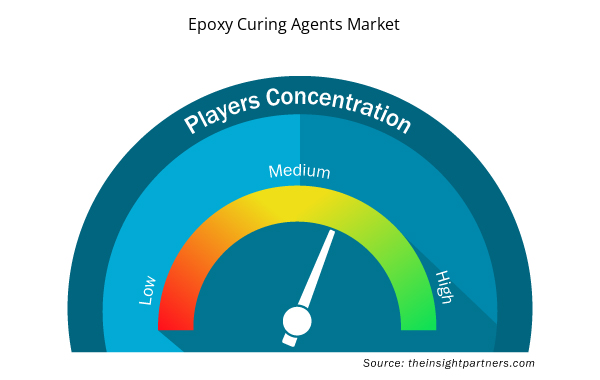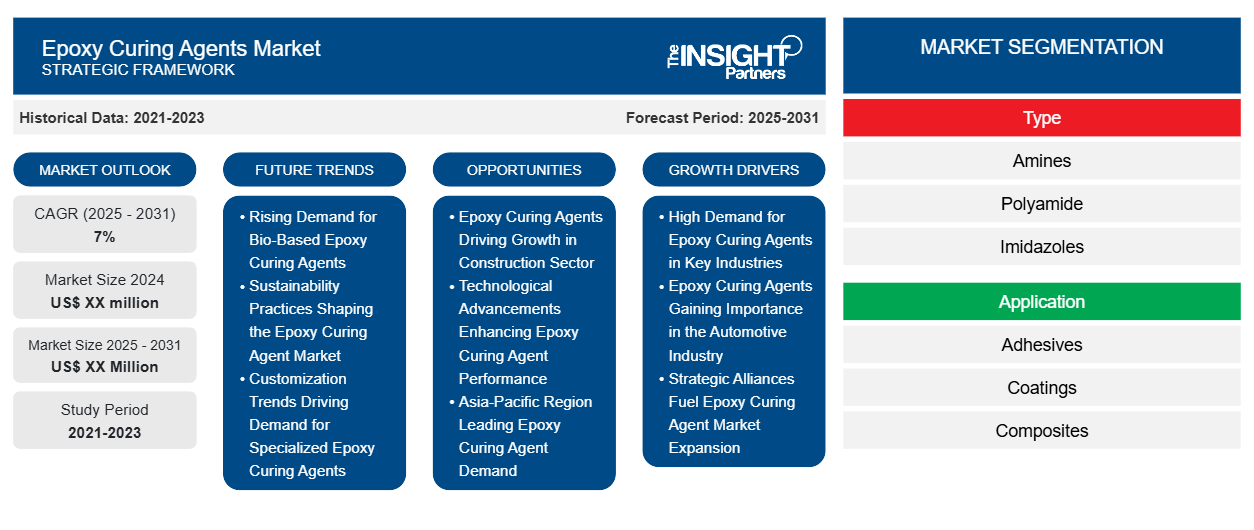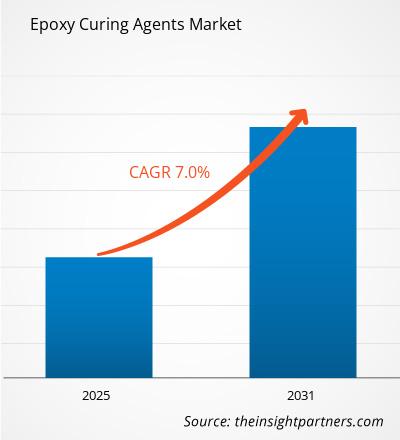Der Markt für Epoxidhärter wird voraussichtlich von 2023 bis 2031 eine durchschnittliche jährliche Wachstumsrate von 7 % verzeichnen, wobei die Marktgröße von XX Millionen US-Dollar im Jahr 2023 auf XX Millionen US-Dollar bis 2031 wachsen wird.
Der Markt für Epoxidhärter umfasst Analysen nach Typ (Amine, Polyamid, Imidazole, Polymercaptan, Anhydride, Sonstiges); Anwendung (Klebstoffe, Beschichtungen, Verbundwerkstoffe, Elektronik, Sonstiges) und Geografie (Nordamerika, Europa, Asien-Pazifik, Naher Osten und Afrika sowie Süd- und Mittelamerika). Pierre Castan, ein Chemiker in der Schweiz, entdeckte 1938 Epoxidharz. Aufgrund seiner Reaktivität gegenüber sowohl elektrophilen als auch nukleophilen Spezies sind Epoxidharze für eine breite Palette von Härtemitteln empfänglich. Epoxidharze gehören zu oligomeren Materialien, die bei weiterer Reaktion mit duroplastischen Polymeren Eigenschaften wie Flexibilität, Haftung an verschiedenen Substraten, geringe Schrumpfung beim Aushärten und gute elektrische Eigenschaften besitzen.
Zweck des Berichts
Der Bericht „Epoxy Curing Agents Market“ von The Insight Partners zielt darauf ab, die aktuelle Situation und das zukünftige Wachstum sowie die wichtigsten treibenden Faktoren, Herausforderungen und Chancen zu beschreiben. Dies wird verschiedenen Geschäftspartnern Einblicke geben, wie zum Beispiel:
- Technologieanbieter/-hersteller: Um die sich entwickelnde Marktdynamik zu verstehen und die potenziellen Wachstumschancen zu kennen, damit sie fundierte strategische Entscheidungen treffen können.
- Investoren: Durchführung einer umfassenden Trendanalyse hinsichtlich der Marktwachstumsrate, der finanziellen Marktprognosen und der Chancen entlang der Wertschöpfungskette.
- Regulierungsbehörden: Zur Regulierung von Richtlinien und Überwachungsaktivitäten auf dem Markt mit dem Ziel, Missbrauch zu minimieren, das Vertrauen der Anleger zu bewahren und die Integrität und Stabilität des Marktes aufrechtzuerhalten.
Epoxidhärter Marktsegmentierung
Typ
- Amine
- Polyamid
- Imidazole
- Polymercaptan
- Anhydride
Anwendung
- Klebstoffe
- Beschichtungen
- Verbundwerkstoffe
- Elektronik
Passen Sie diesen Bericht Ihren Anforderungen an
Sie erhalten kostenlos individuelle Anpassungen an jedem Bericht, einschließlich Teilen dieses Berichts oder einer Analyse auf Länderebene, eines Excel-Datenpakets sowie tolle Angebote und Rabatte für Start-ups und Universitäten.
- Holen Sie sich die wichtigsten Markttrends aus diesem Bericht.Dieses KOSTENLOSE Beispiel umfasst eine Datenanalyse von Markttrends bis hin zu Schätzungen und Prognosen.
Wachstumstreiber auf dem Markt für Epoxidhärter
- Hohe Nachfrage nach Epoxidhärtern in Schlüsselindustrien: Epoxidhärter sind vor allem aufgrund ihrer breiten Anwendungsmöglichkeiten in der Bau-, Automobil-, Luftfahrt- und Elektronikindustrie gefragt. In diesen Branchen werden von den Anwendern Hochleistungsbeschichtungsmaterialien, Klebstoffe und Verbundwerkstoffe benötigt, und Epoxidharze können diese erfolgreich liefern.
- Epoxidhärter gewinnen in der Automobilindustrie an Bedeutung: Mit dem Aufkommen von Elektrofahrzeugen steigt die Verwendung von leichten und starren Materialien täglich. Epoxidhärter gewinnen in der Automobilindustrie für hochfeste und hitzebeständige Anwendungen an Bedeutung.
- Strategische Allianzen treiben die Expansion des Marktes für Epoxidhärter voran: Strategische Allianzen mit führenden Akteuren in bestimmten Branchen sollen den Zugang zu neuen Märkten und neuen Produkten ermöglichen. Eine kollaborative Allianz mit Forschungsorganisationen wird die Entwicklung innovativer Produkte vorantreiben und zur Schaffung dieser beitragen, was Wachstum und Wettbewerbsvorteile mit sich bringt. Wichtige Akteure sind an Produktinnovationen beteiligt, um der wachsenden Verbrauchernachfrage gerecht zu werden.
Markttrends für Epoxidhärter
- Steigende Nachfrage nach biobasierten Epoxidhärtern: Aufgrund der hohen Nachfrage nach nachhaltigen und umweltfreundlichen Produkten in den verschiedenen Marktsegmenten wurden biobasierte Härter entwickelt. Nachhaltigkeit gewinnt daher an Bedeutung und löst diesen Materialwechsel aus, um Innovationen zu beschleunigen und mehr Produktlinien auf dem Markt für Epoxidhärter anzubieten.
- Nachhaltigkeitspraktiken prägen den Markt für Epoxidhärter: Tatsächlich wird branchenübergreifend Wert auf Nachhaltigkeitspraktiken gelegt. Und dies hat vielerorts einen Trend zu biobasierten Epoxidhärtern gezeigt. Die Hauptgründe für diesen Wechsel sind Umweltvorteile und die Tatsache, dass sie sehr strengen Vorschriften entsprechen.
- Anpassungstrends treiben die Nachfrage nach speziellen Epoxidhärtern: Wenn Unternehmen auf maßgeschneiderte Lösungen setzen, ist ihr Bedarf anwendungsspezifisch; daher besteht eine größere Nachfrage nach speziellen Epoxidhärtern. Eine stärkere Betonung von kundenspezifischen Produkten mit besonderen Leistungsanforderungen würde die Vielfalt der von einem Hersteller bereitgestellten Angebote deutlich machen.
Marktchancen für Epoxidhärter
- Epoxidhärter treiben das Wachstum im Bausektor an: Epoxidhärter werden im Bausektor stark verbraucht, insbesondere bei Bodenbelägen und Schutzbeschichtungen. Urbanisierung und Ausbau der Infrastruktur werden voraussichtlich weltweit an Fahrt gewinnen und den Markt weiter ankurbeln, da sie eine Nachfrage nach langlebigen und hochwertigen Materialien schaffen.
- Technologische Fortschritte verbessern die Leistung von Epoxidhärtern: Durch technologische Fortschritte werden die Leistungsmerkmale von Epoxidhärtern ständig verbessert, um sie für ein wachsendes Anwendungsspektrum attraktiver zu machen. Fortschritte bei Formulierungen und Verarbeitungstechniken wurden fortgesetzt, und es folgten Verbesserungen bei der Qualität und Funktionalität der Produkte.
- Asien-Pazifik-Region mit der höchsten Nachfrage nach Epoxidhärtern: Industrialisierung und Fertigungsaktivitäten in der Asien-Pazifik-Region dürften die Marktführer sein. China und Indien dürften die beiden größten Nachfragetreiber für Epoxidhärter sein, da diese Länder ihre Wirtschaft mit bedeutenden Wachstums- und Infrastrukturprojekten vorantreiben.
Regionale Einblicke in den Markt für Epoxidhärter
Die regionalen Trends und Faktoren, die den Markt für Epoxidhärter im Prognosezeitraum beeinflussen, wurden von den Analysten von Insight Partners ausführlich erläutert. In diesem Abschnitt werden auch die Marktsegmente und die Geografie für Epoxidhärter in Nordamerika, Europa, im asiatisch-pazifischen Raum, im Nahen Osten und Afrika sowie in Süd- und Mittelamerika erörtert.

- Erhalten Sie regionale Daten zum Markt für Epoxidhärter
Umfang des Marktberichts zu Epoxidhärtern
| Berichtsattribut | Details |
|---|---|
| Marktgröße im Jahr 2024 | XX Millionen US-Dollar |
| Marktgröße bis 2031 | XX Millionen US-Dollar |
| Globale CAGR (2024 - 2031) | 7 % |
| Historische Daten | 2021-2023 |
| Prognosezeitraum | 2025–2031 |
| Abgedeckte Segmente | Nach Typ
|
| Abgedeckte Regionen und Länder | Nordamerika
|
| Marktführer und wichtige Unternehmensprofile |
|
Dichte der Marktteilnehmer für Epoxidhärter: Auswirkungen auf die Geschäftsdynamik verstehen
Der Markt für Epoxidhärter wächst rasant, angetrieben durch die steigende Nachfrage der Endverbraucher aufgrund von Faktoren wie sich entwickelnden Verbraucherpräferenzen, technologischen Fortschritten und einem größeren Bewusstsein für die Vorteile des Produkts. Mit steigender Nachfrage erweitern Unternehmen ihr Angebot, entwickeln Innovationen, um die Bedürfnisse der Verbraucher zu erfüllen, und nutzen neue Trends, was das Marktwachstum weiter ankurbelt.
Die Marktteilnehmerdichte bezieht sich auf die Verteilung der Firmen oder Unternehmen, die in einem bestimmten Markt oder einer bestimmten Branche tätig sind. Sie gibt an, wie viele Wettbewerber (Marktteilnehmer) in einem bestimmten Marktraum im Verhältnis zu seiner Größe oder seinem gesamten Marktwert präsent sind.
Die wichtigsten auf dem Markt für Epoxidhärter tätigen Unternehmen sind:
- Aditya Birla Chemicals (Thailand) Ltd.
- Atul Limited
- BASF SE
- Cardolite Corporation
- Evonik Industries
Haftungsausschluss : Die oben aufgeführten Unternehmen sind nicht in einer bestimmten Reihenfolge aufgeführt.

- Überblick über die wichtigsten Akteure auf dem Markt für Epoxidhärter
Wichtige Verkaufsargumente
- Umfassende Abdeckung: Der Bericht deckt die Analyse der Produkte, Dienste, Typen und Endbenutzer des Epoxidhärtermarktes umfassend ab und bietet einen ganzheitlichen Überblick.
- Expertenanalyse: Der Bericht basiert auf dem umfassenden Verständnis von Branchenexperten und Analysten.
- Aktuelle Informationen: Der Bericht stellt durch die Abdeckung aktueller Informationen und Datentrends Geschäftsrelevanz sicher.
- Anpassungsoptionen: Dieser Bericht kann angepasst werden, um spezifische Kundenanforderungen zu erfüllen und die Geschäftsstrategien optimal anzupassen.
Der Forschungsbericht zum Markt für Epoxidhärter kann daher dabei helfen, die Branchensituation und Wachstumsaussichten zu entschlüsseln und zu verstehen. Obwohl es einige berechtigte Bedenken geben kann, überwiegen die allgemeinen Vorteile dieses Berichts tendenziell die Nachteile.
- Historische Analyse (2 Jahre), Basisjahr, Prognose (7 Jahre) mit CAGR
- PEST- und SWOT-Analyse
- Marktgröße Wert/Volumen – Global, Regional, Land
- Branche und Wettbewerbsumfeld
- Excel-Datensatz



Report Coverage
Revenue forecast, Company Analysis, Industry landscape, Growth factors, and Trends

Segment Covered
This text is related
to segments covered.

Regional Scope
North America, Europe, Asia Pacific, Middle East & Africa, South & Central America

Country Scope
This text is related
to country scope.
Häufig gestellte Fragen
The increasing demand for eco-friendly epoxy curing agents is an emerging trend in the market.
The Asia Pacific market is expected to account for the highest CAGR over the forecast period.
The adhesives application segment accounted for the largest market share in 2023.
Aditya Birla Chemicals (Thailand) Ltd, Atul Limited, BASF SE, Cardolite Corporation, Evonik Industries, Hexion Inc, Huntsman Corporation, Kukdo Chemical Co., Ltd, Mitsubishi Chemical Corporation, and Olin Corporation are some of the key players operating in the market.
The increased demand from automation industry is a key driver in the market.
The Epoxy Curing Agents Market is estimated to witness a CAGR of 7% from 2023 to 2031
Trends and growth analysis reports related to Chemicals and Materials : READ MORE..
1.Aditya Birla Chemicals (Thailand) Ltd.
2.Atul Limited
3.BASF SE
4.Cardolite Corporation
5.Evonik Industries
6.Hexion Inc.
7.Huntsman Corporation
8.Kukdo Chemical Co., Ltd.
9.Mitsubishi Chemical Corporation
10.Olin Corporation
The Insight Partners performs research in 4 major stages: Data Collection & Secondary Research, Primary Research, Data Analysis and Data Triangulation & Final Review.
- Data Collection and Secondary Research:
As a market research and consulting firm operating from a decade, we have published and advised several client across the globe. First step for any study will start with an assessment of currently available data and insights from existing reports. Further, historical and current market information is collected from Investor Presentations, Annual Reports, SEC Filings, etc., and other information related to company’s performance and market positioning are gathered from Paid Databases (Factiva, Hoovers, and Reuters) and various other publications available in public domain.
Several associations trade associates, technical forums, institutes, societies and organization are accessed to gain technical as well as market related insights through their publications such as research papers, blogs and press releases related to the studies are referred to get cues about the market. Further, white papers, journals, magazines, and other news articles published in last 3 years are scrutinized and analyzed to understand the current market trends.
- Primary Research:
The primarily interview analysis comprise of data obtained from industry participants interview and answers to survey questions gathered by in-house primary team.
For primary research, interviews are conducted with industry experts/CEOs/Marketing Managers/VPs/Subject Matter Experts from both demand and supply side to get a 360-degree view of the market. The primary team conducts several interviews based on the complexity of the markets to understand the various market trends and dynamics which makes research more credible and precise.
A typical research interview fulfils the following functions:
- Provides first-hand information on the market size, market trends, growth trends, competitive landscape, and outlook
- Validates and strengthens in-house secondary research findings
- Develops the analysis team’s expertise and market understanding
Primary research involves email interactions and telephone interviews for each market, category, segment, and sub-segment across geographies. The participants who typically take part in such a process include, but are not limited to:
- Industry participants: VPs, business development managers, market intelligence managers and national sales managers
- Outside experts: Valuation experts, research analysts and key opinion leaders specializing in the electronics and semiconductor industry.
Below is the breakup of our primary respondents by company, designation, and region:

Once we receive the confirmation from primary research sources or primary respondents, we finalize the base year market estimation and forecast the data as per the macroeconomic and microeconomic factors assessed during data collection.
- Data Analysis:
Once data is validated through both secondary as well as primary respondents, we finalize the market estimations by hypothesis formulation and factor analysis at regional and country level.
- Macro-Economic Factor Analysis:
We analyse macroeconomic indicators such the gross domestic product (GDP), increase in the demand for goods and services across industries, technological advancement, regional economic growth, governmental policies, the influence of COVID-19, PEST analysis, and other aspects. This analysis aids in setting benchmarks for various nations/regions and approximating market splits. Additionally, the general trend of the aforementioned components aid in determining the market's development possibilities.
- Country Level Data:
Various factors that are especially aligned to the country are taken into account to determine the market size for a certain area and country, including the presence of vendors, such as headquarters and offices, the country's GDP, demand patterns, and industry growth. To comprehend the market dynamics for the nation, a number of growth variables, inhibitors, application areas, and current market trends are researched. The aforementioned elements aid in determining the country's overall market's growth potential.
- Company Profile:
The “Table of Contents” is formulated by listing and analyzing more than 25 - 30 companies operating in the market ecosystem across geographies. However, we profile only 10 companies as a standard practice in our syndicate reports. These 10 companies comprise leading, emerging, and regional players. Nonetheless, our analysis is not restricted to the 10 listed companies, we also analyze other companies present in the market to develop a holistic view and understand the prevailing trends. The “Company Profiles” section in the report covers key facts, business description, products & services, financial information, SWOT analysis, and key developments. The financial information presented is extracted from the annual reports and official documents of the publicly listed companies. Upon collecting the information for the sections of respective companies, we verify them via various primary sources and then compile the data in respective company profiles. The company level information helps us in deriving the base number as well as in forecasting the market size.
- Developing Base Number:
Aggregation of sales statistics (2020-2022) and macro-economic factor, and other secondary and primary research insights are utilized to arrive at base number and related market shares for 2022. The data gaps are identified in this step and relevant market data is analyzed, collected from paid primary interviews or databases. On finalizing the base year market size, forecasts are developed on the basis of macro-economic, industry and market growth factors and company level analysis.
- Data Triangulation and Final Review:
The market findings and base year market size calculations are validated from supply as well as demand side. Demand side validations are based on macro-economic factor analysis and benchmarks for respective regions and countries. In case of supply side validations, revenues of major companies are estimated (in case not available) based on industry benchmark, approximate number of employees, product portfolio, and primary interviews revenues are gathered. Further revenue from target product/service segment is assessed to avoid overshooting of market statistics. In case of heavy deviations between supply and demand side values, all thes steps are repeated to achieve synchronization.
We follow an iterative model, wherein we share our research findings with Subject Matter Experts (SME’s) and Key Opinion Leaders (KOLs) until consensus view of the market is not formulated – this model negates any drastic deviation in the opinions of experts. Only validated and universally acceptable research findings are quoted in our reports.
We have important check points that we use to validate our research findings – which we call – data triangulation, where we validate the information, we generate from secondary sources with primary interviews and then we re-validate with our internal data bases and Subject matter experts. This comprehensive model enables us to deliver high quality, reliable data in shortest possible time.


 Holen Sie sich ein kostenloses Muster für diesen Bericht
Holen Sie sich ein kostenloses Muster für diesen Bericht